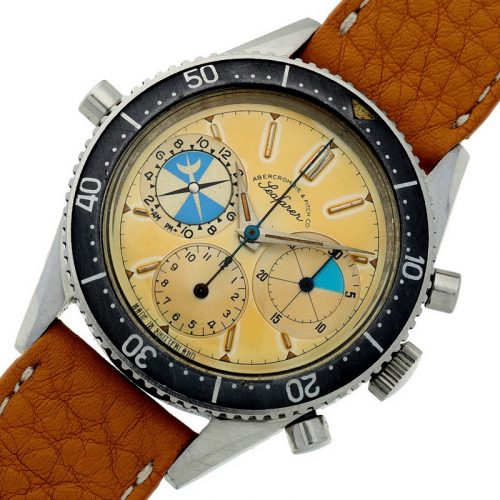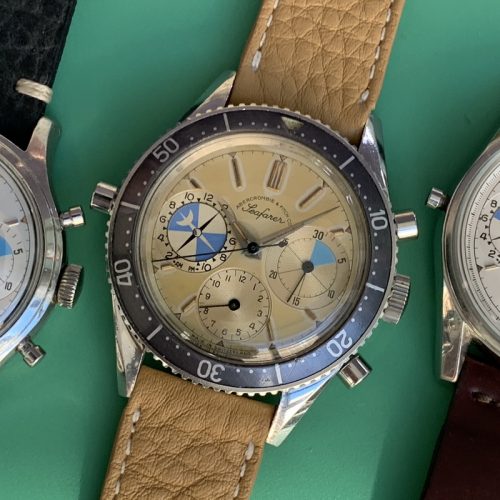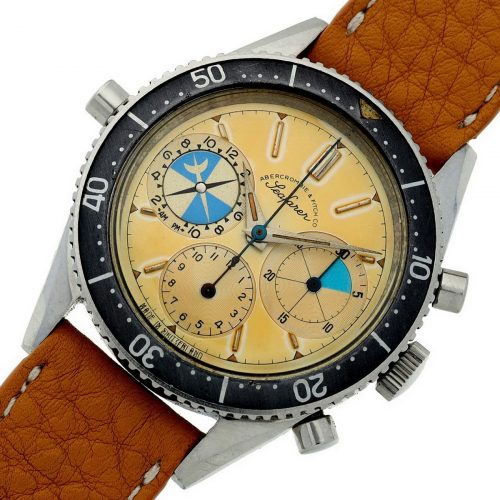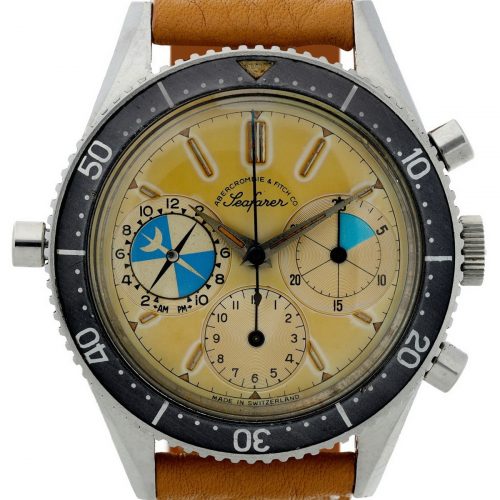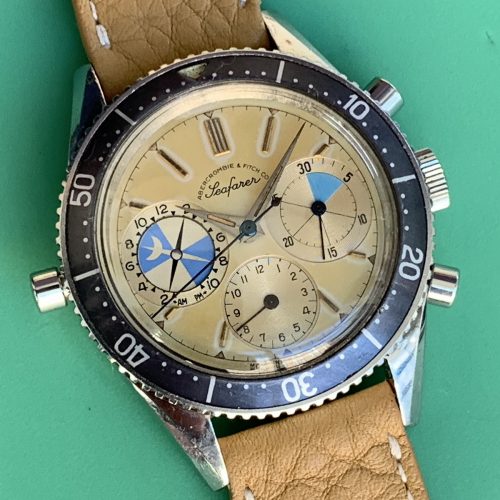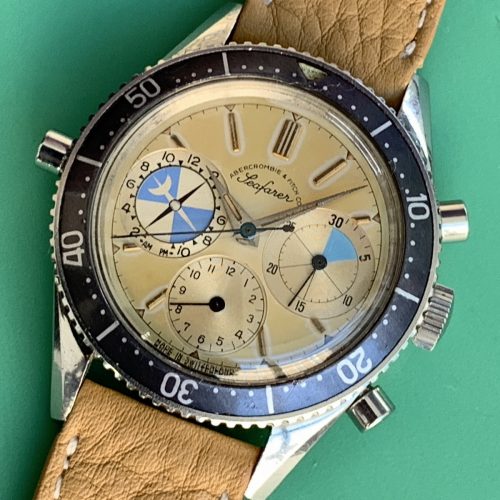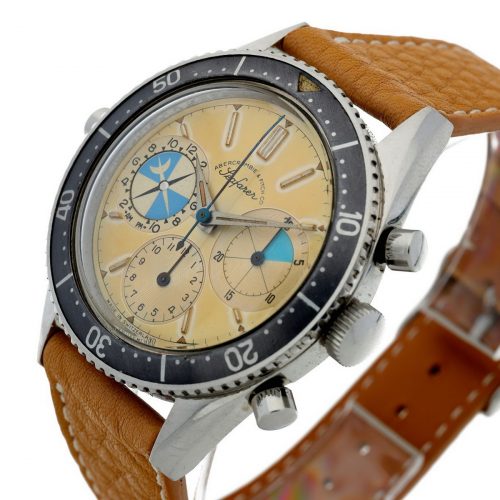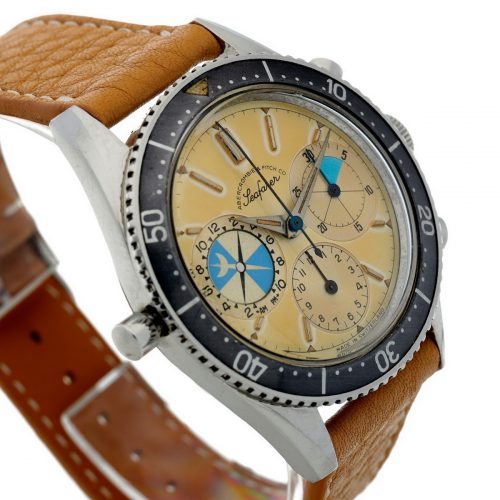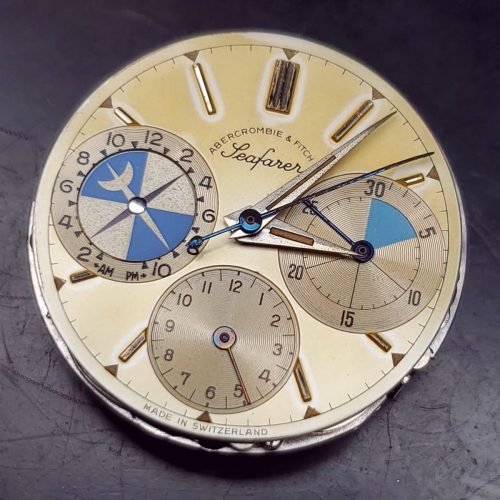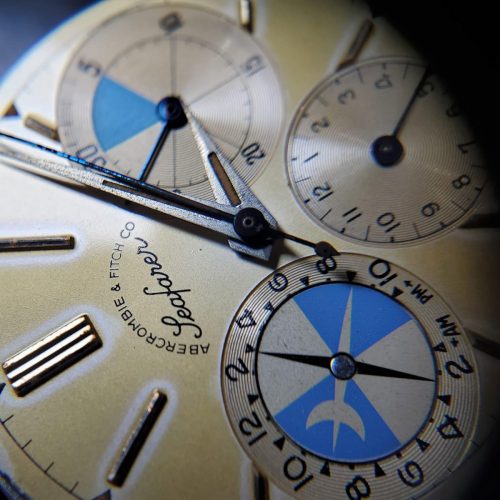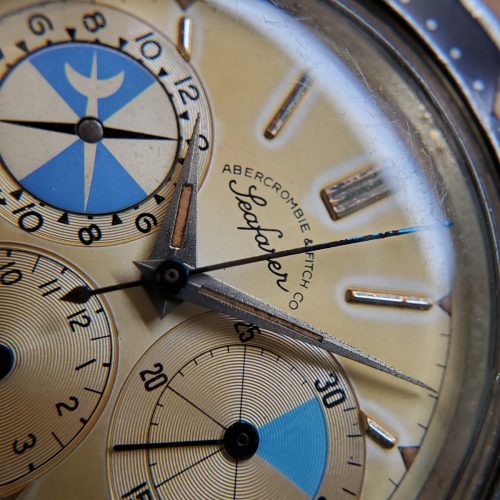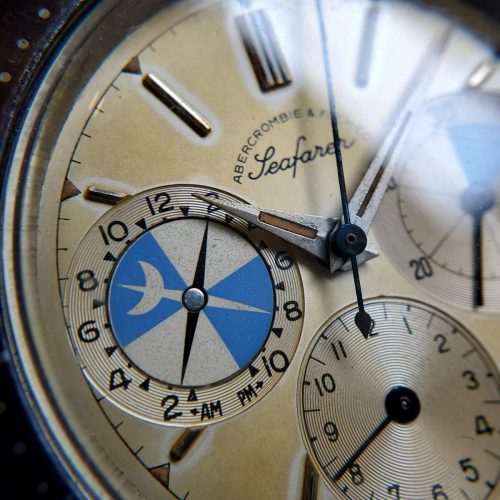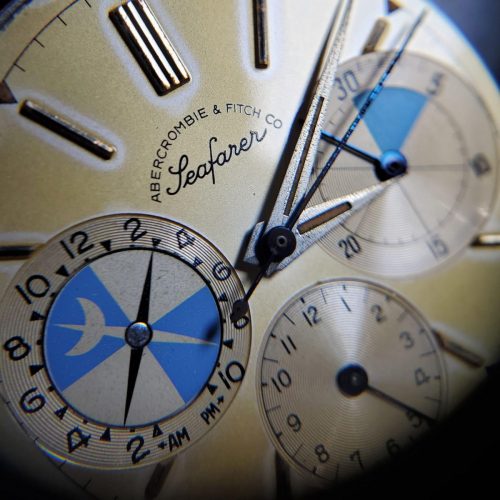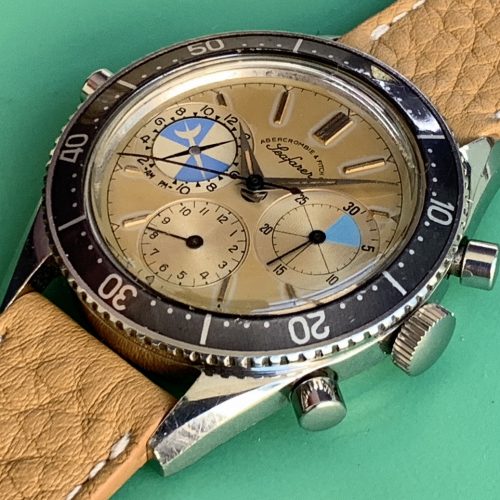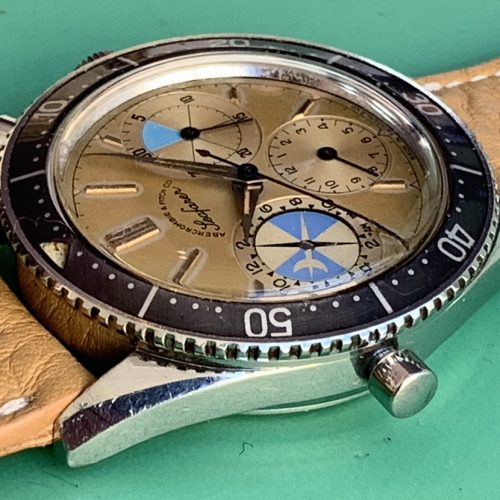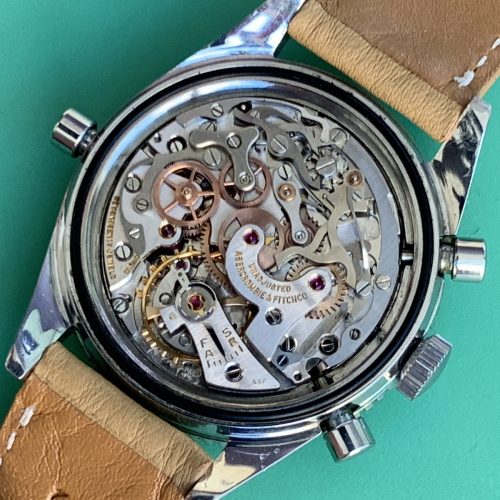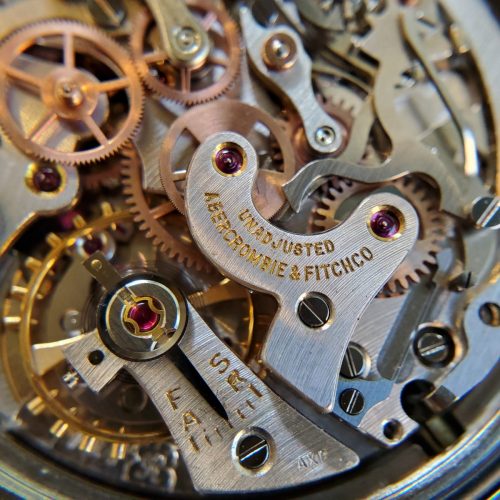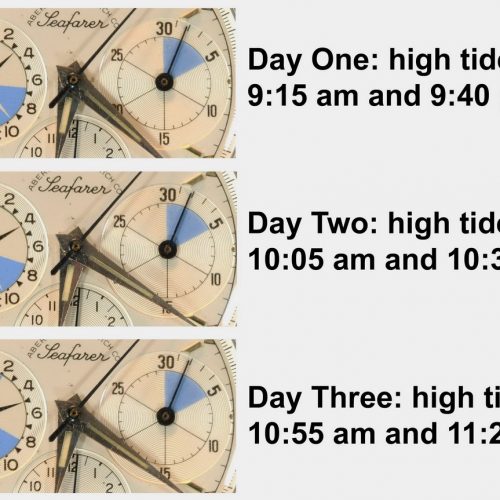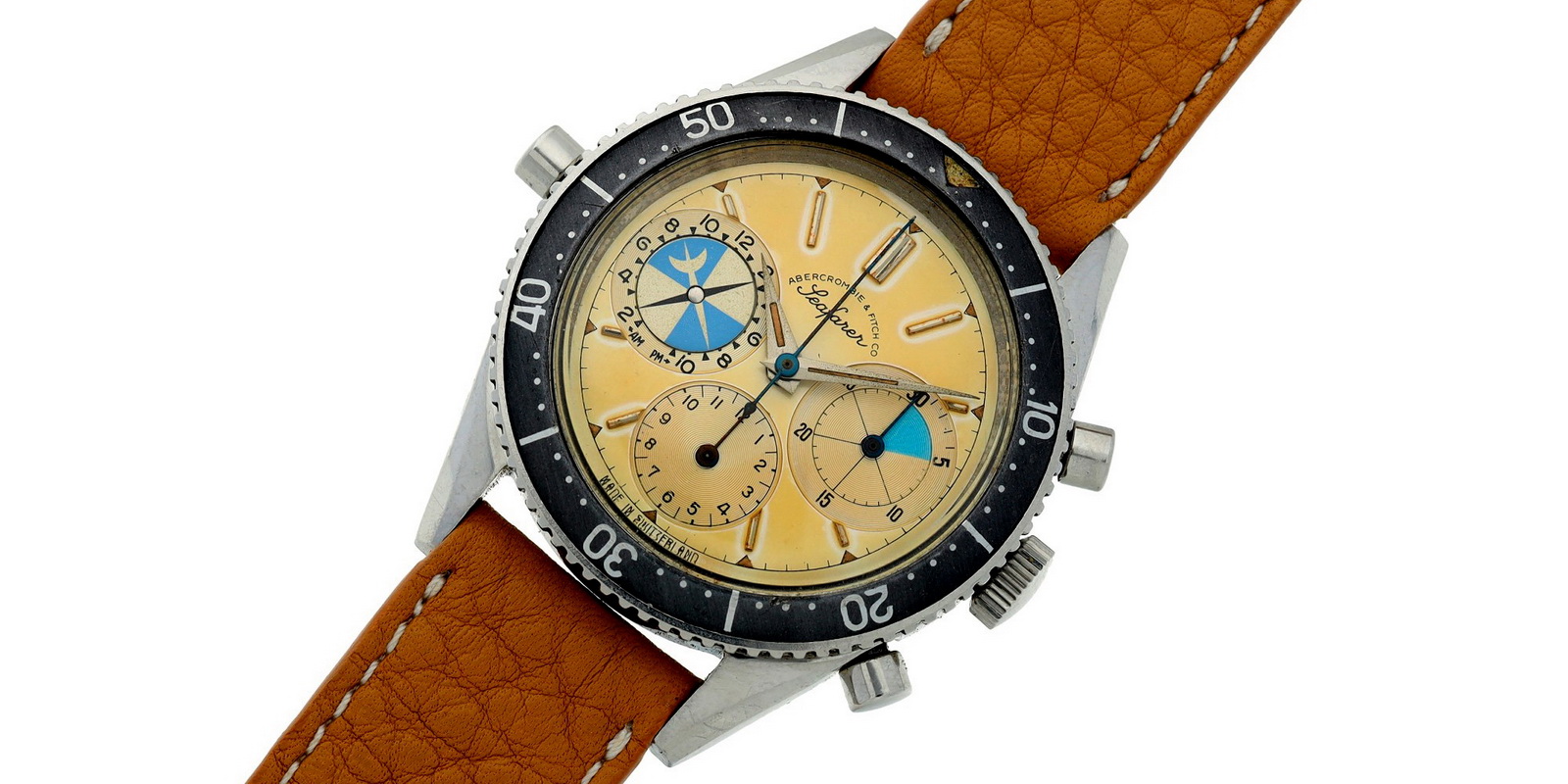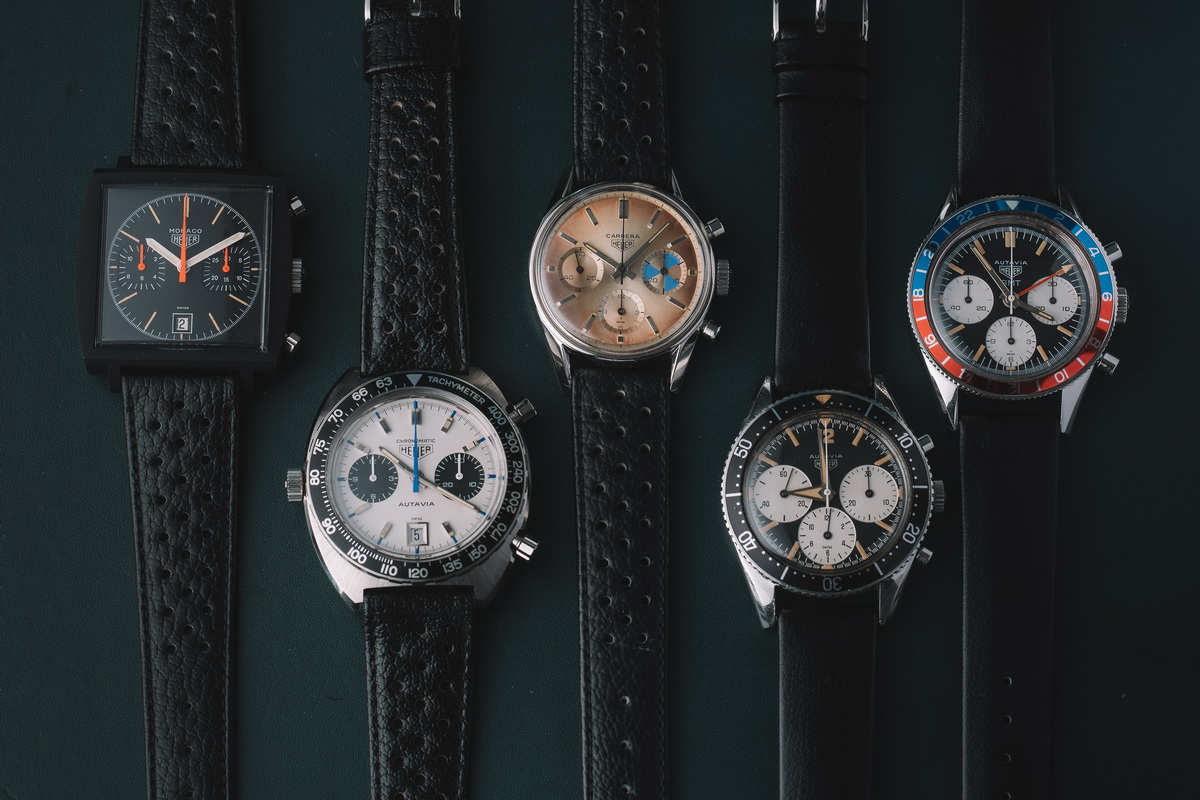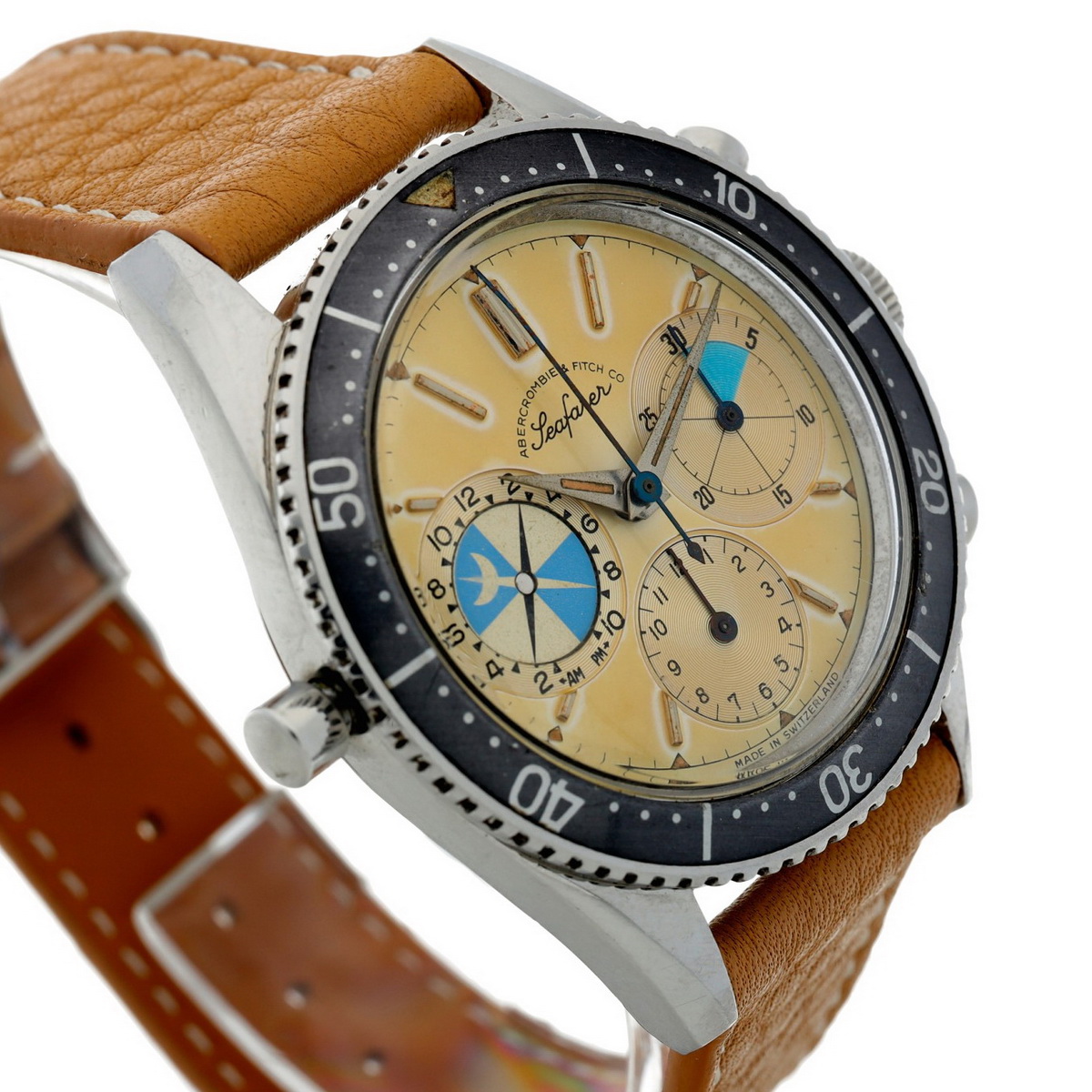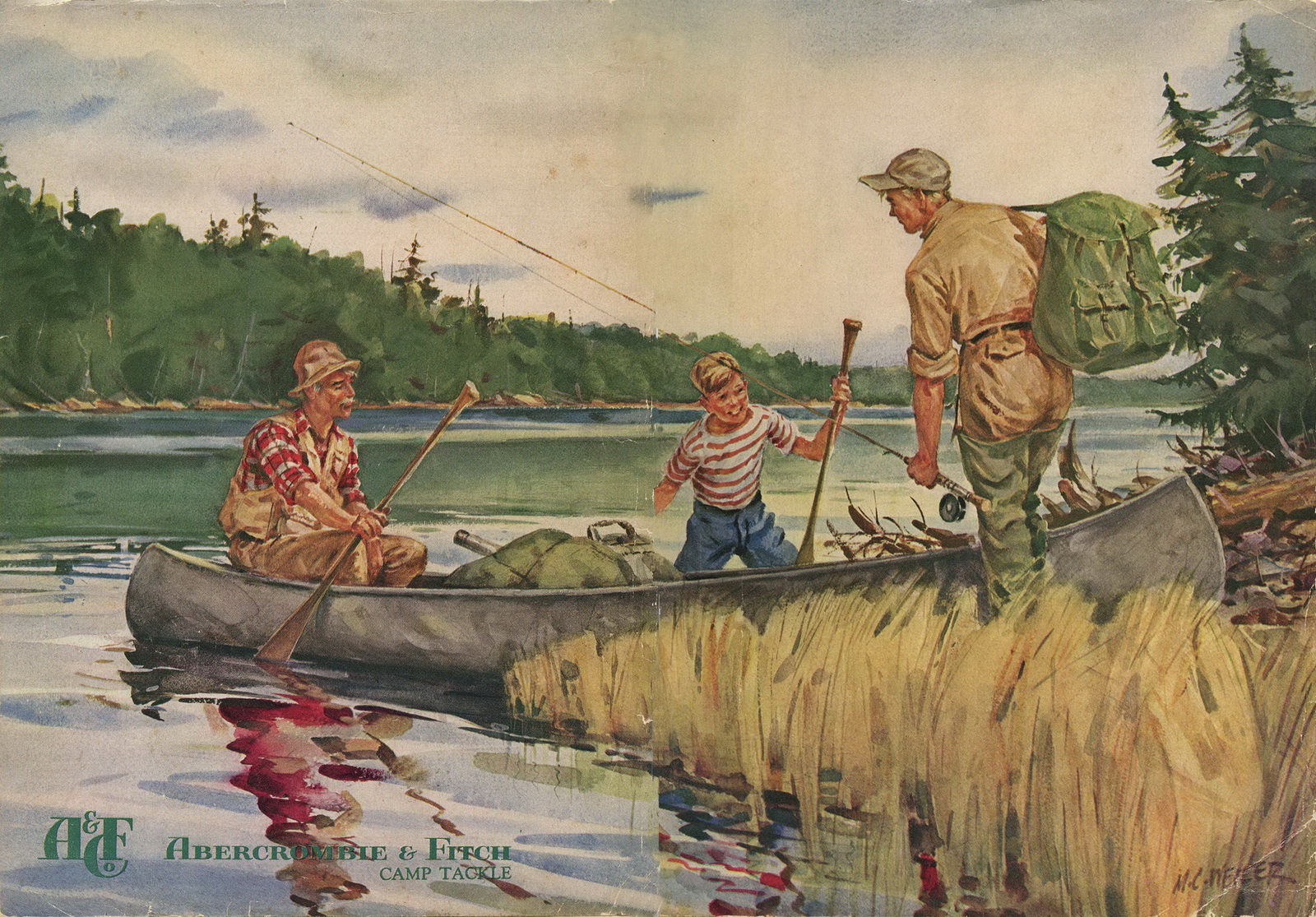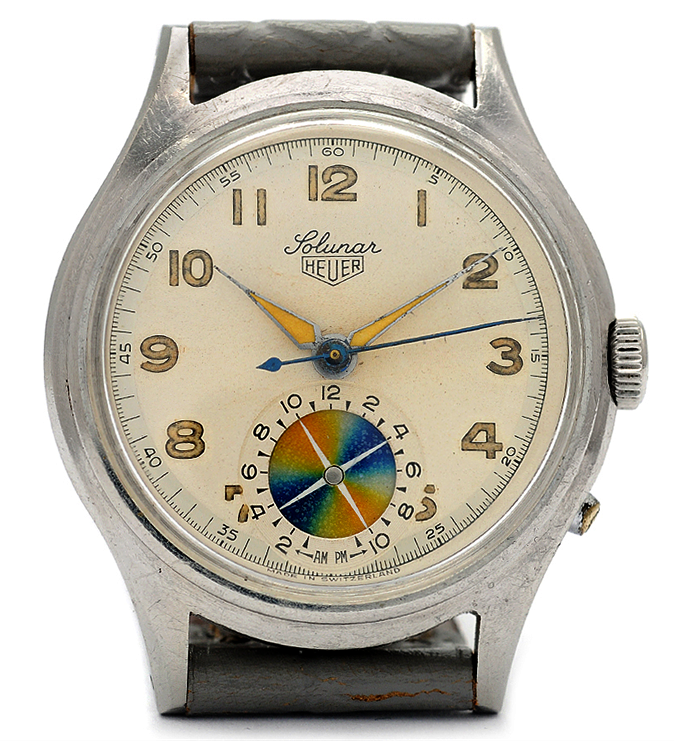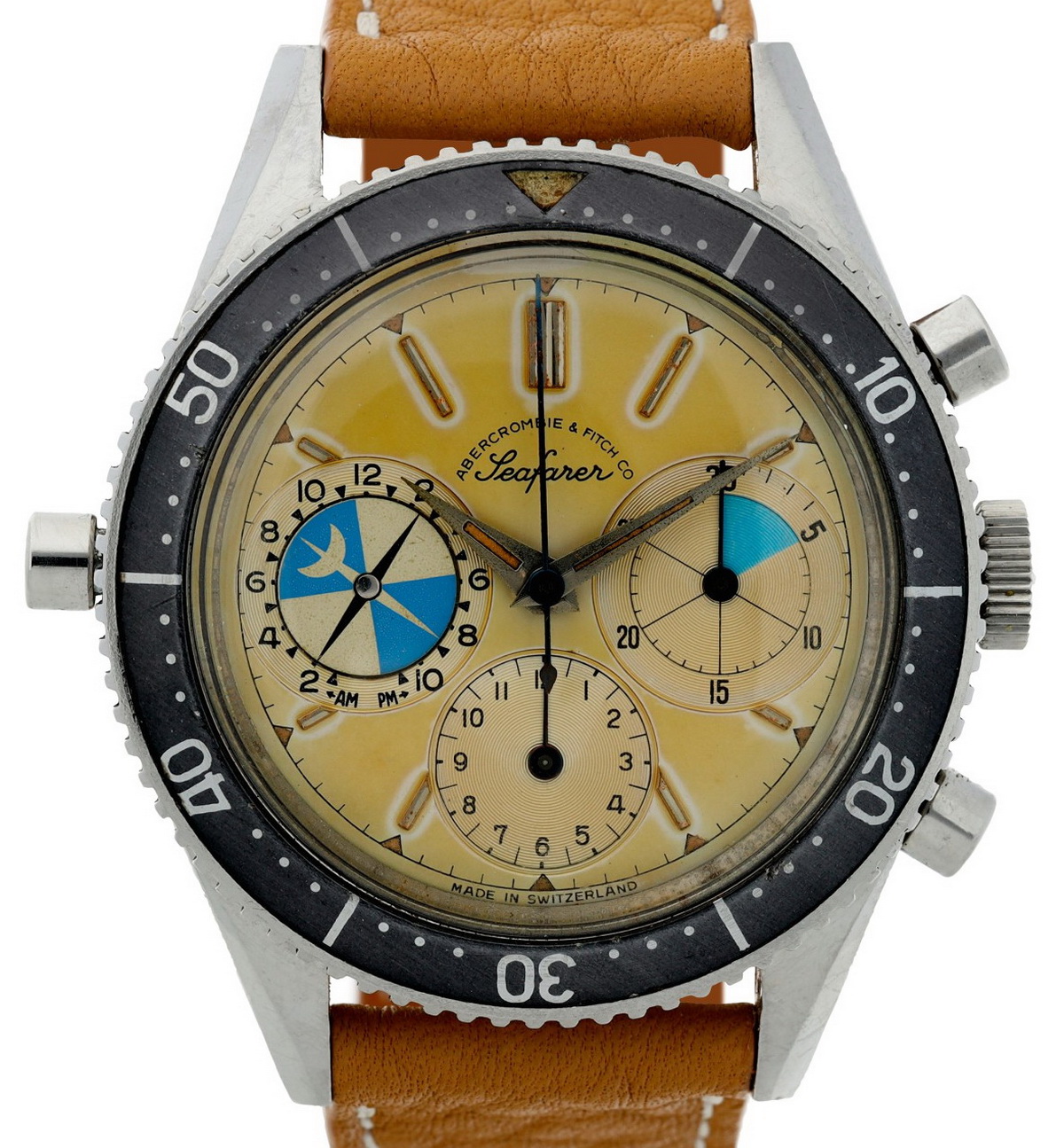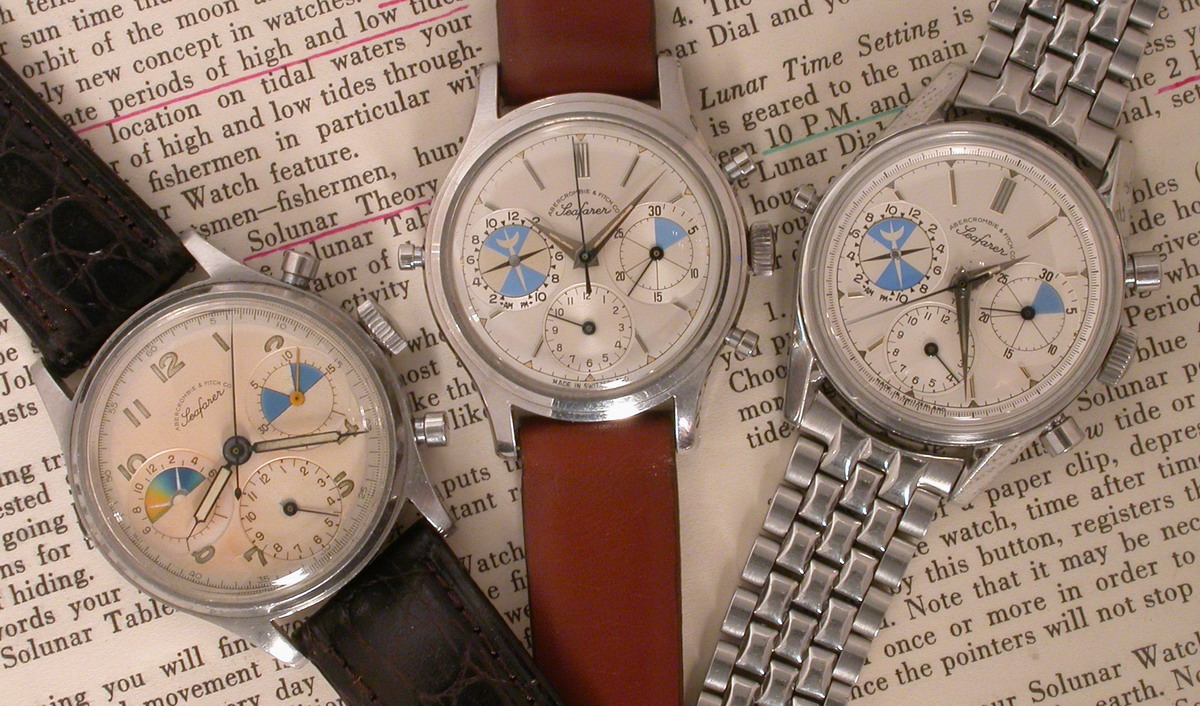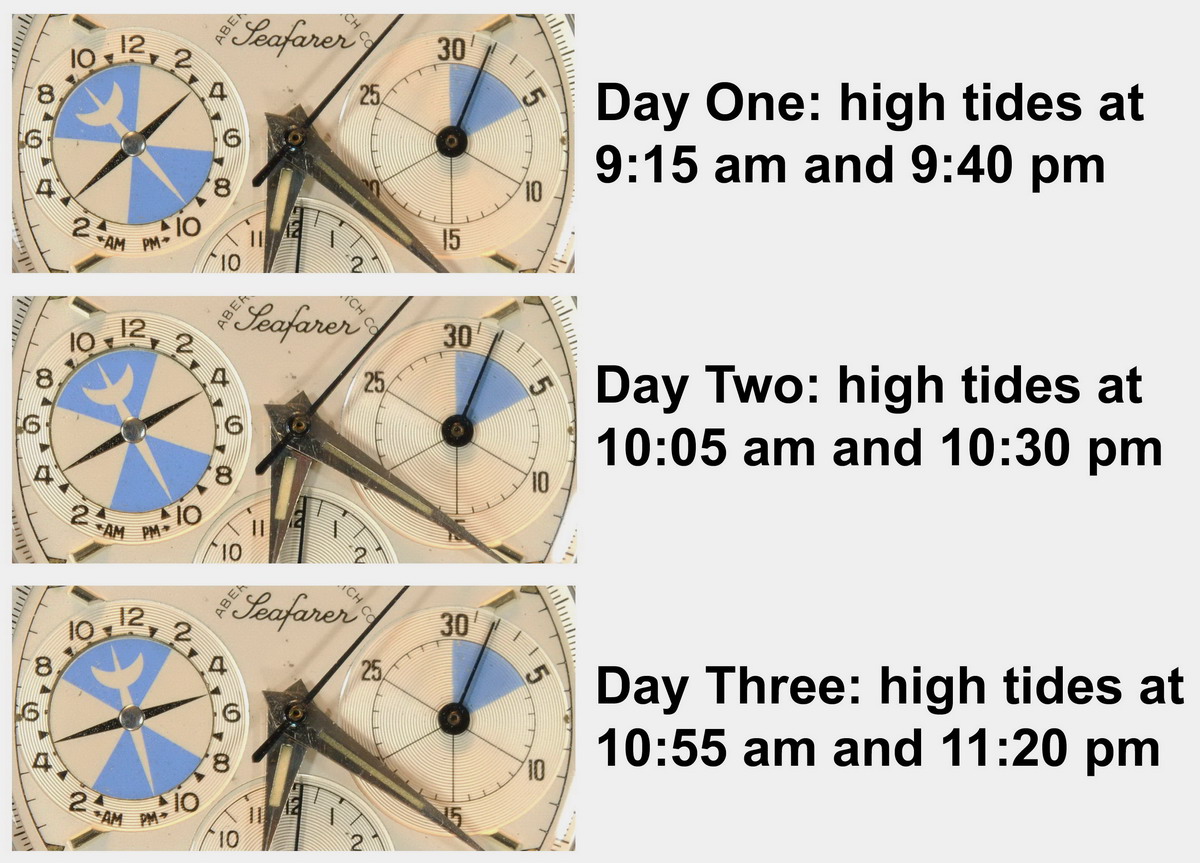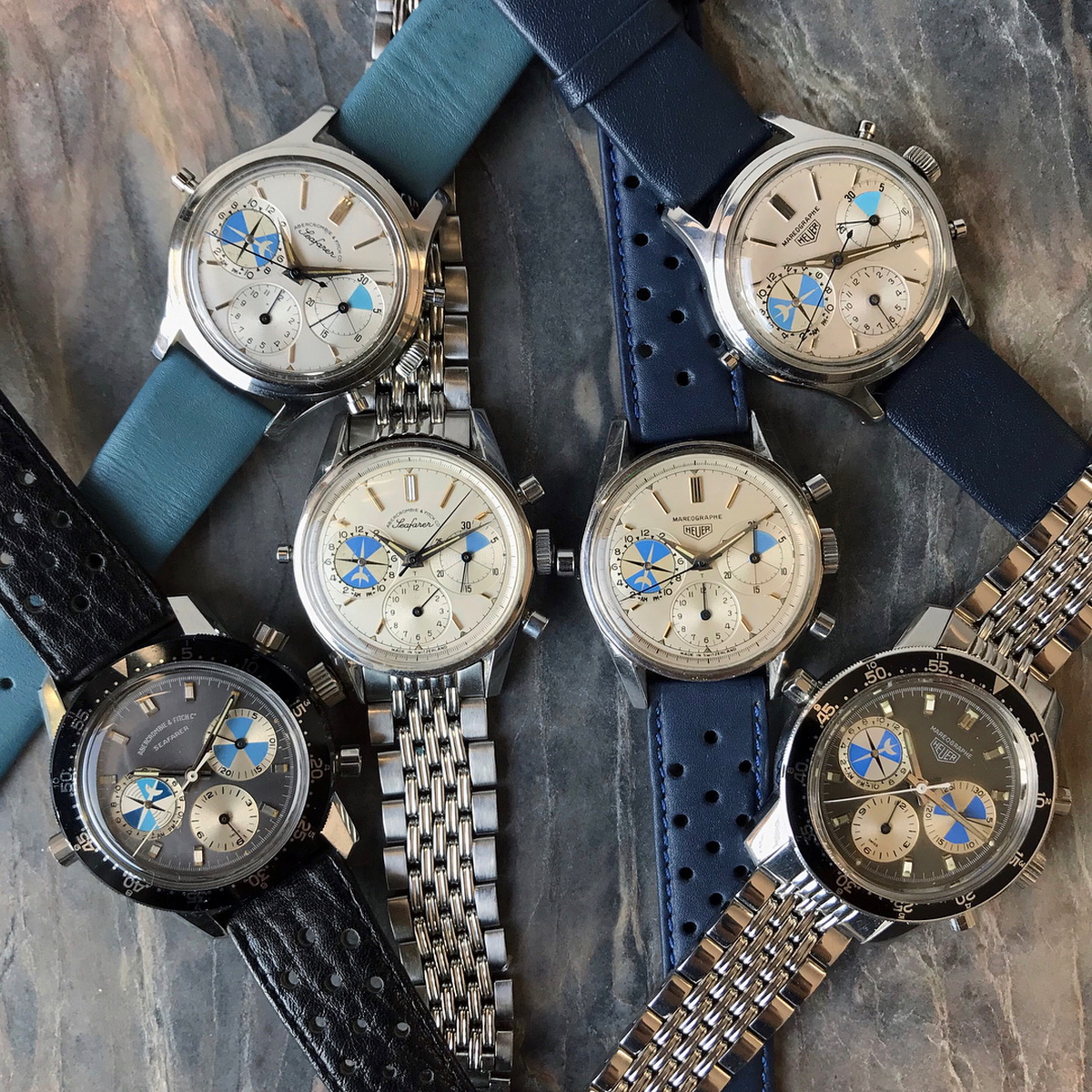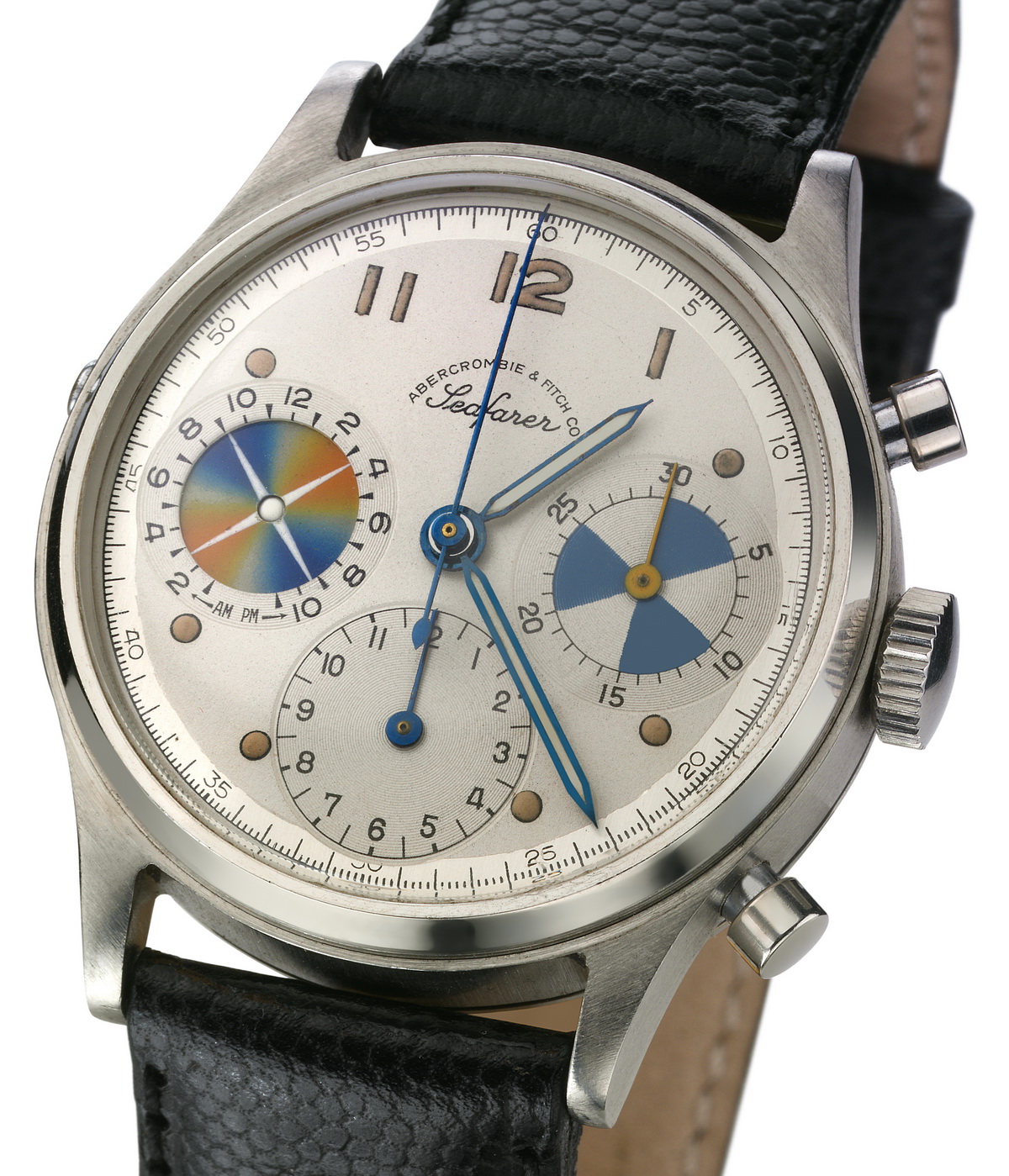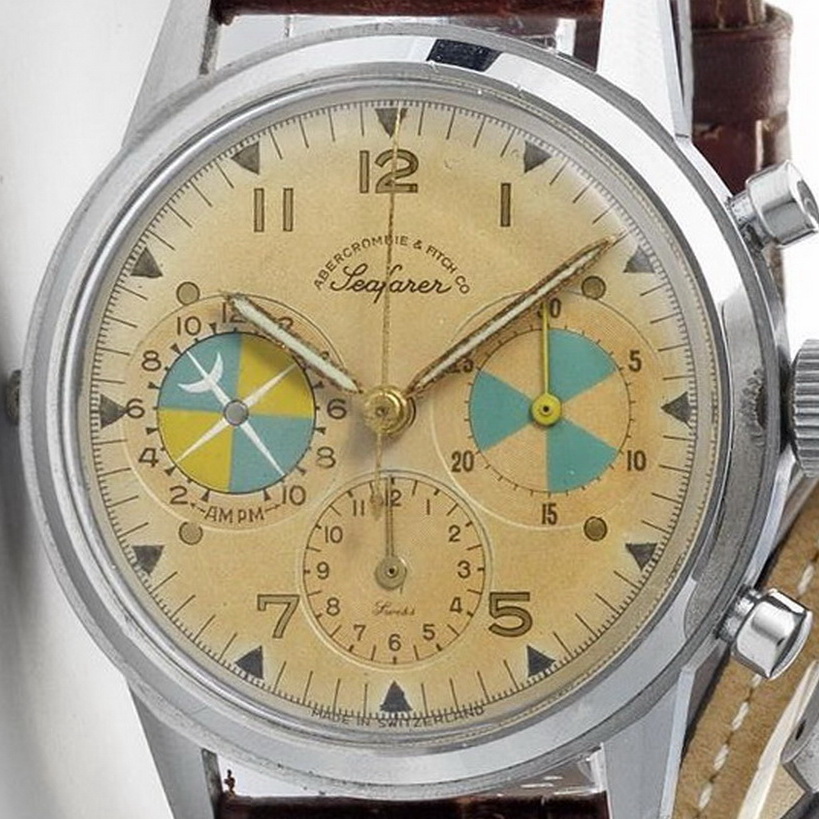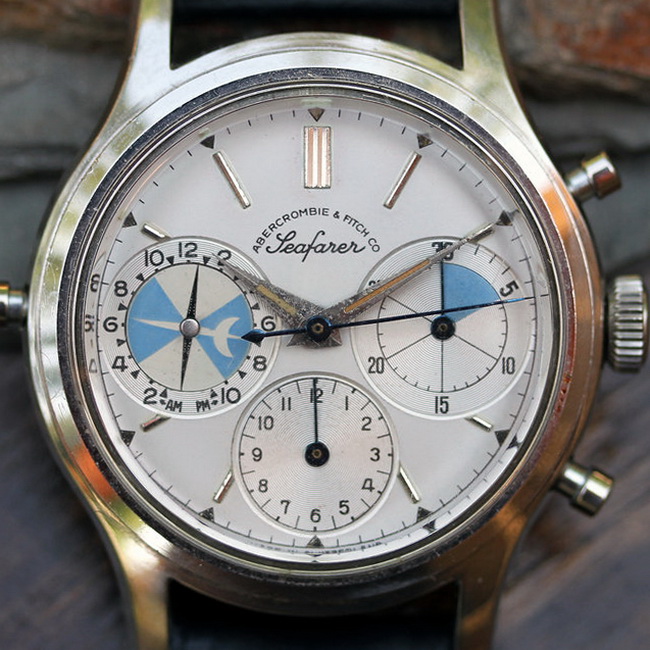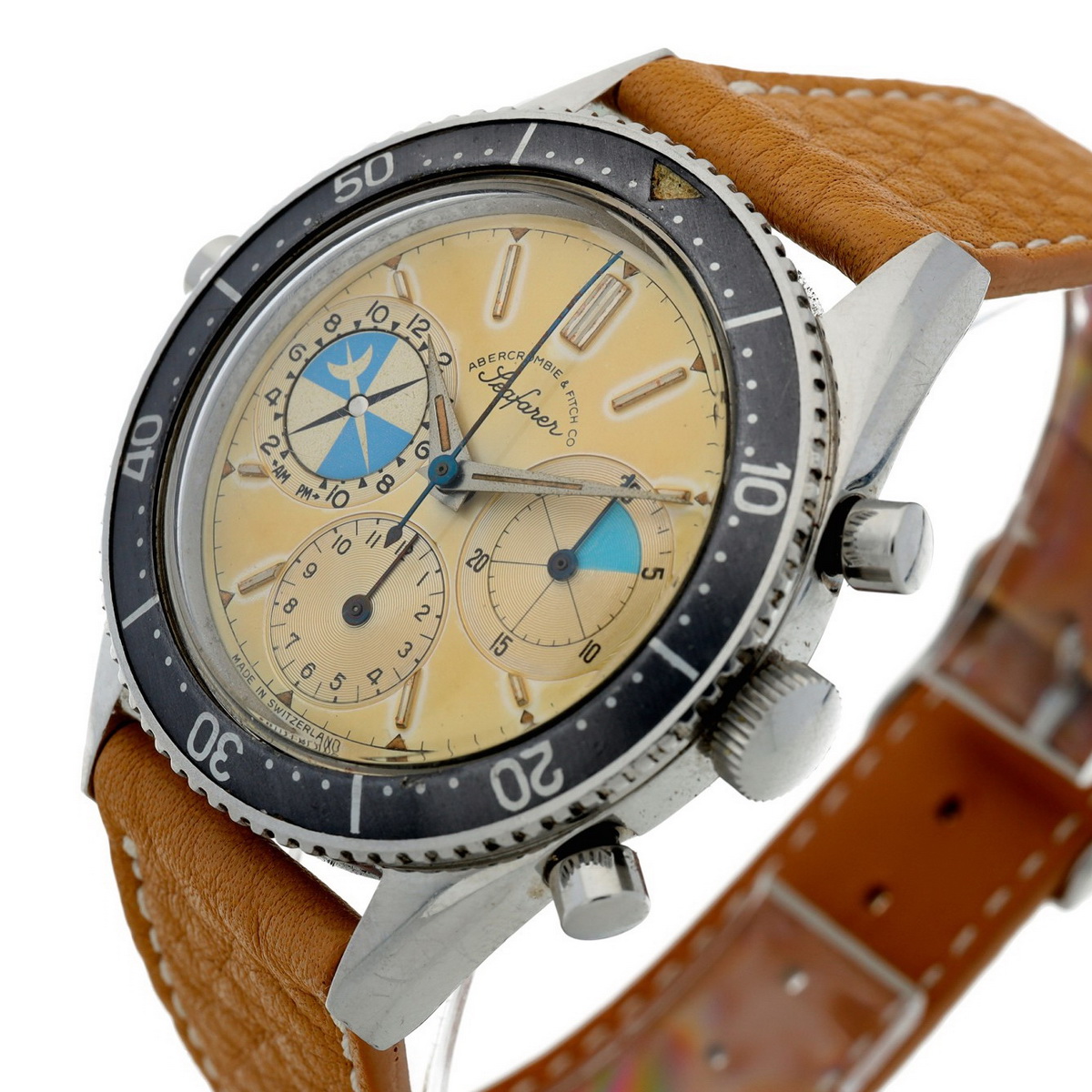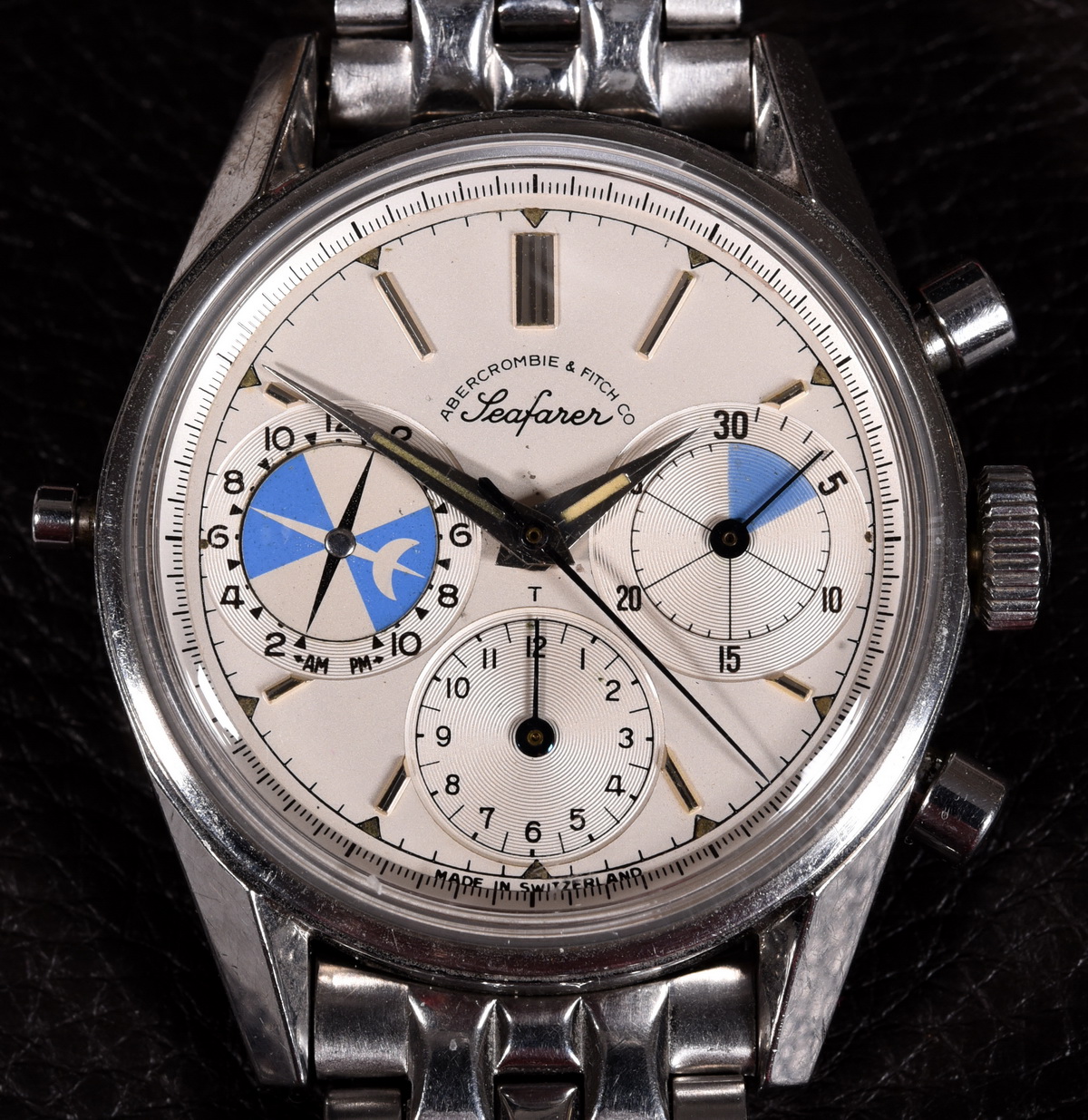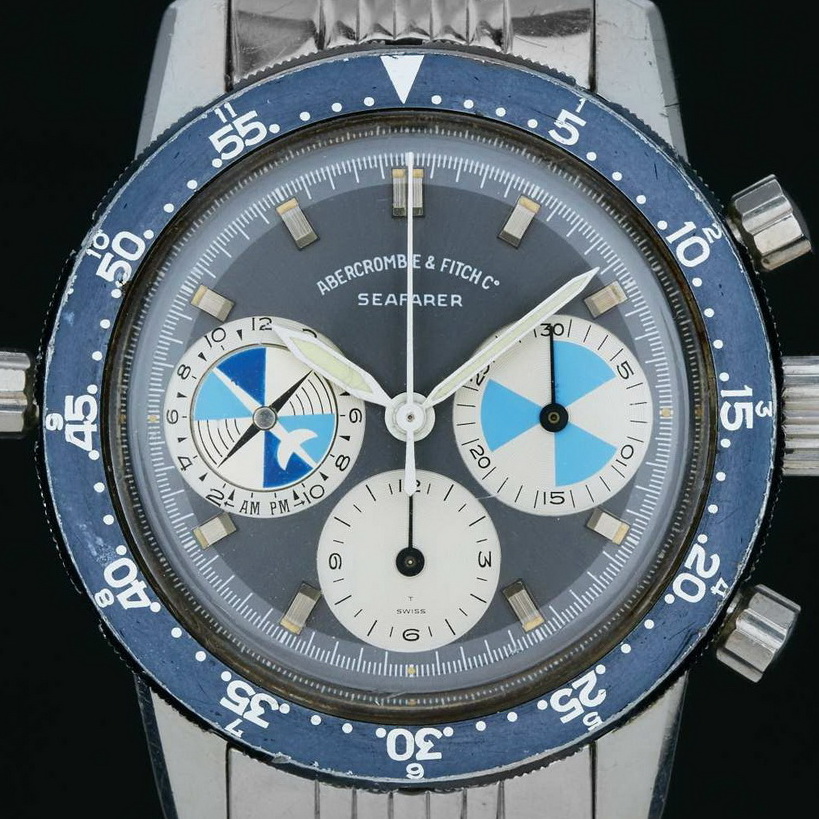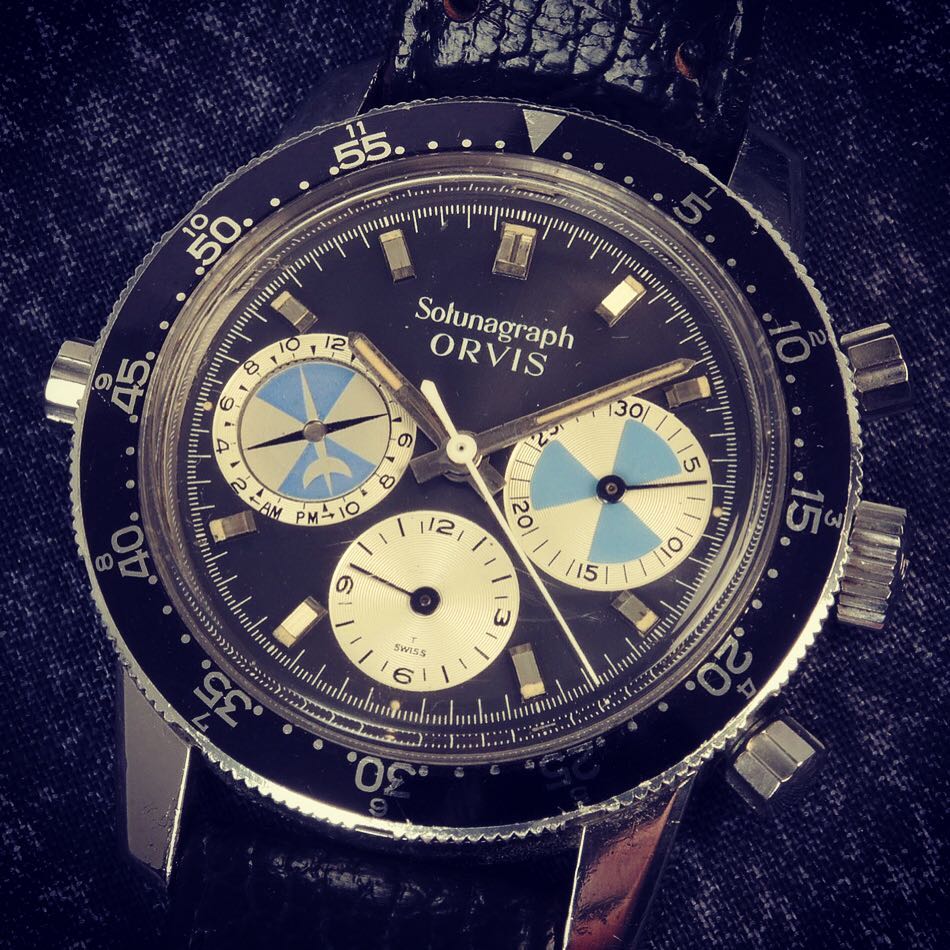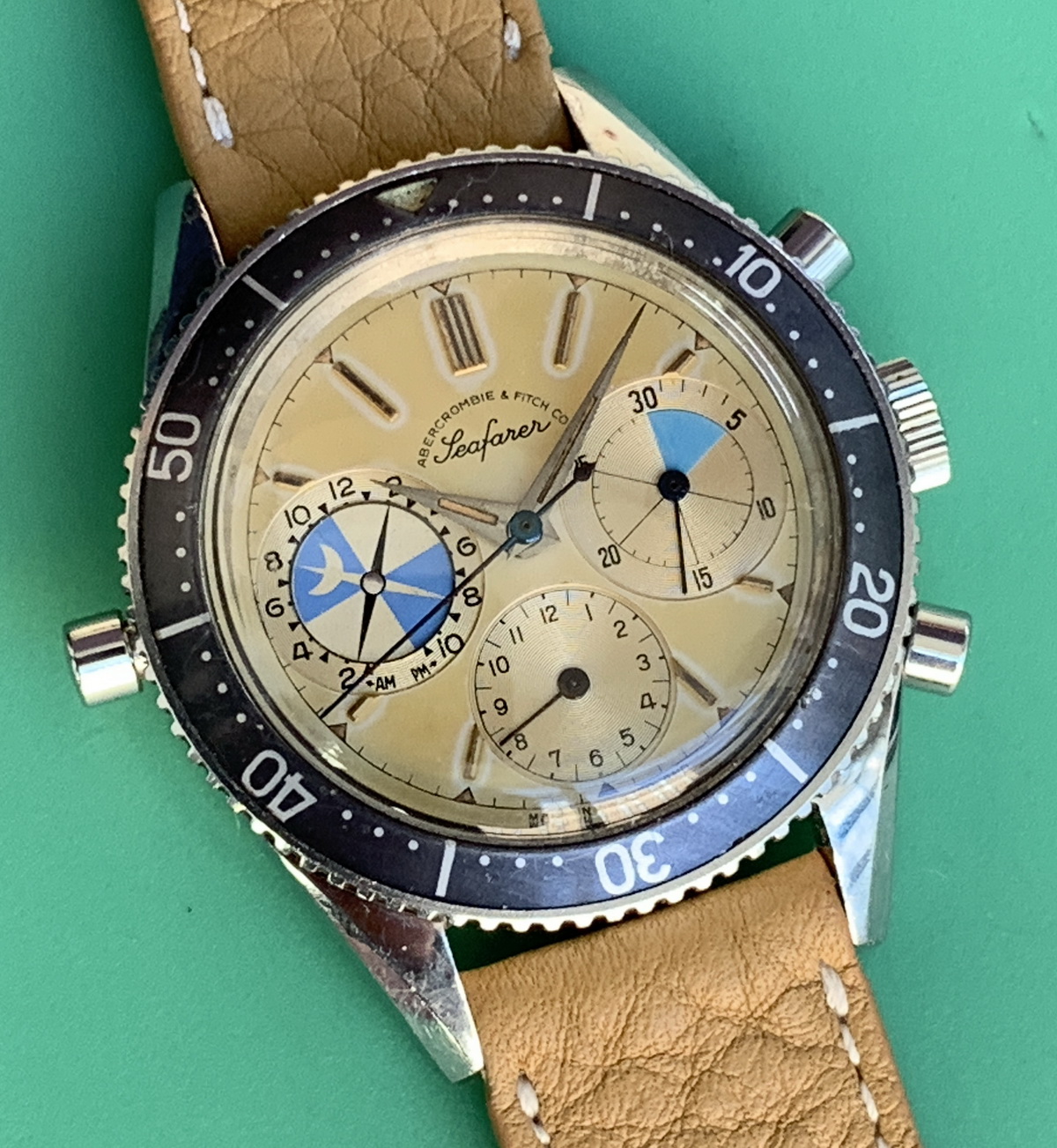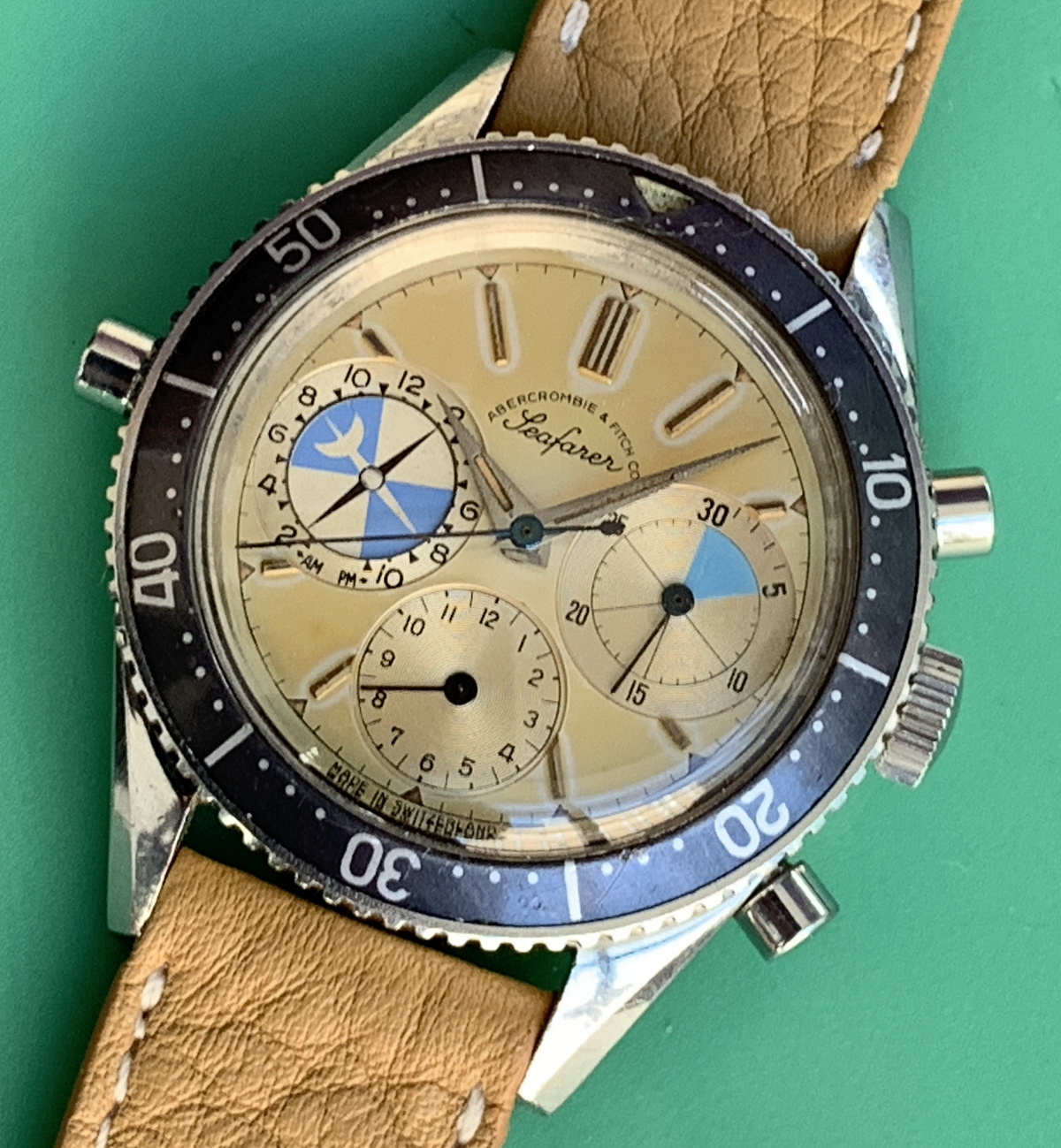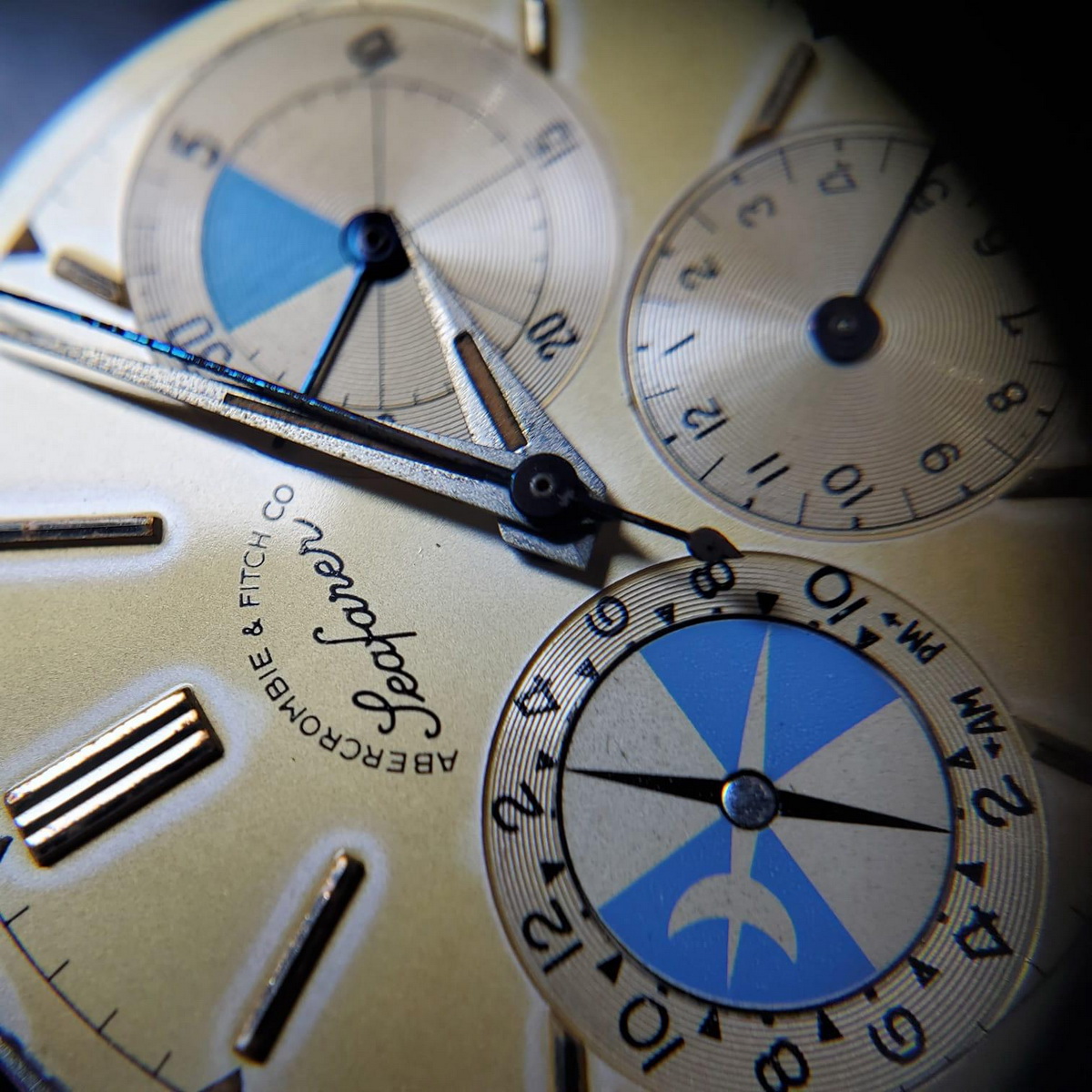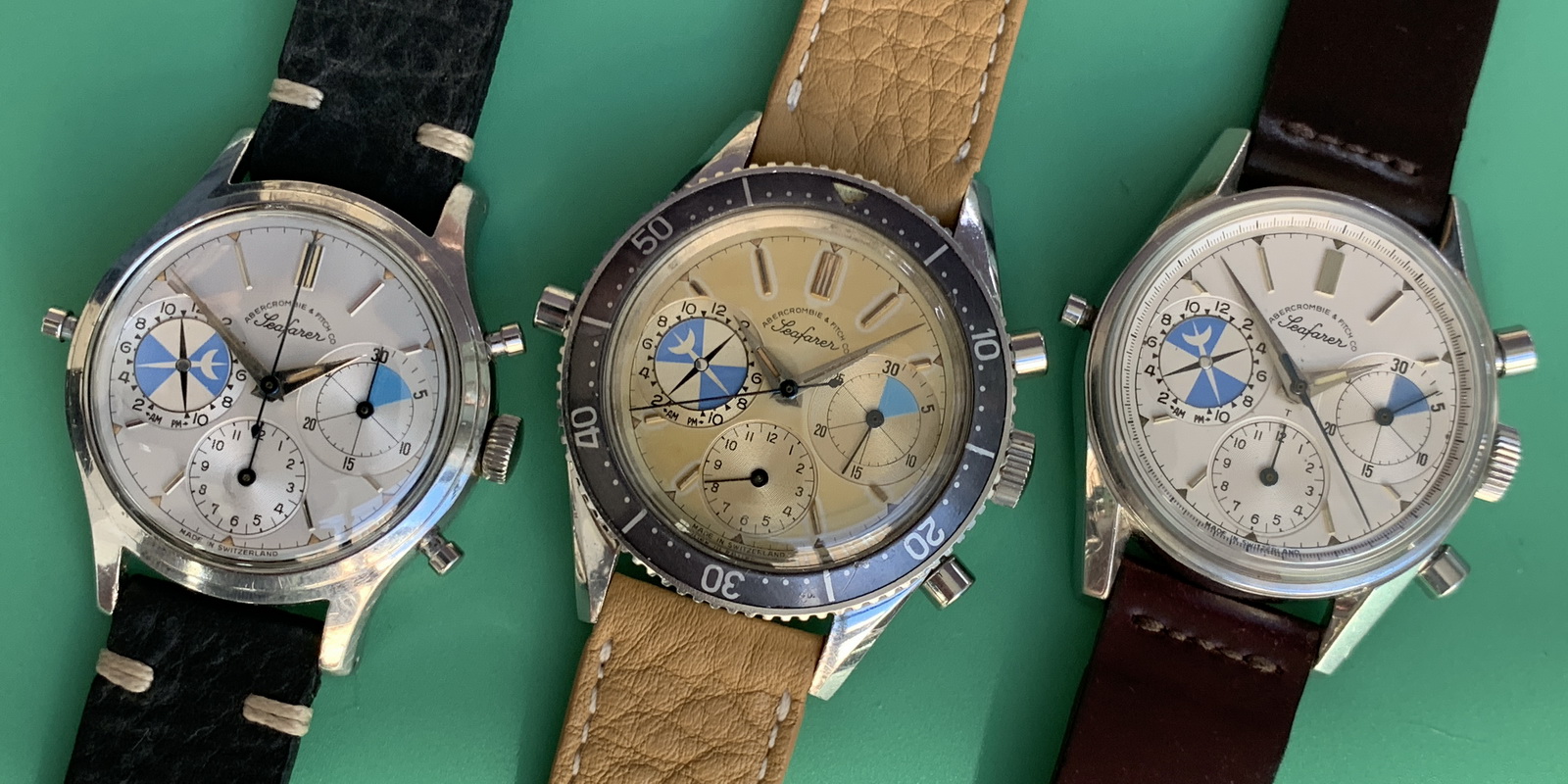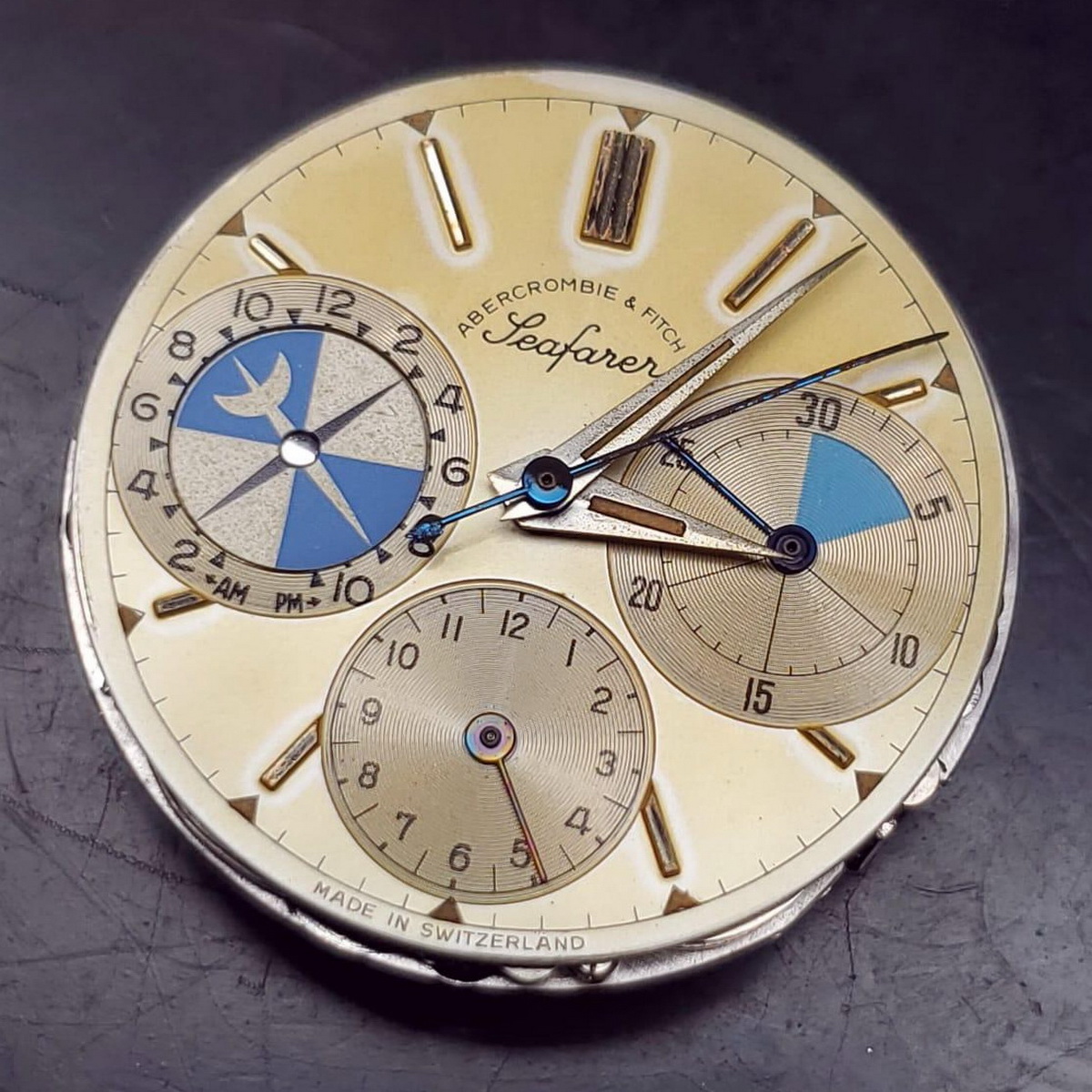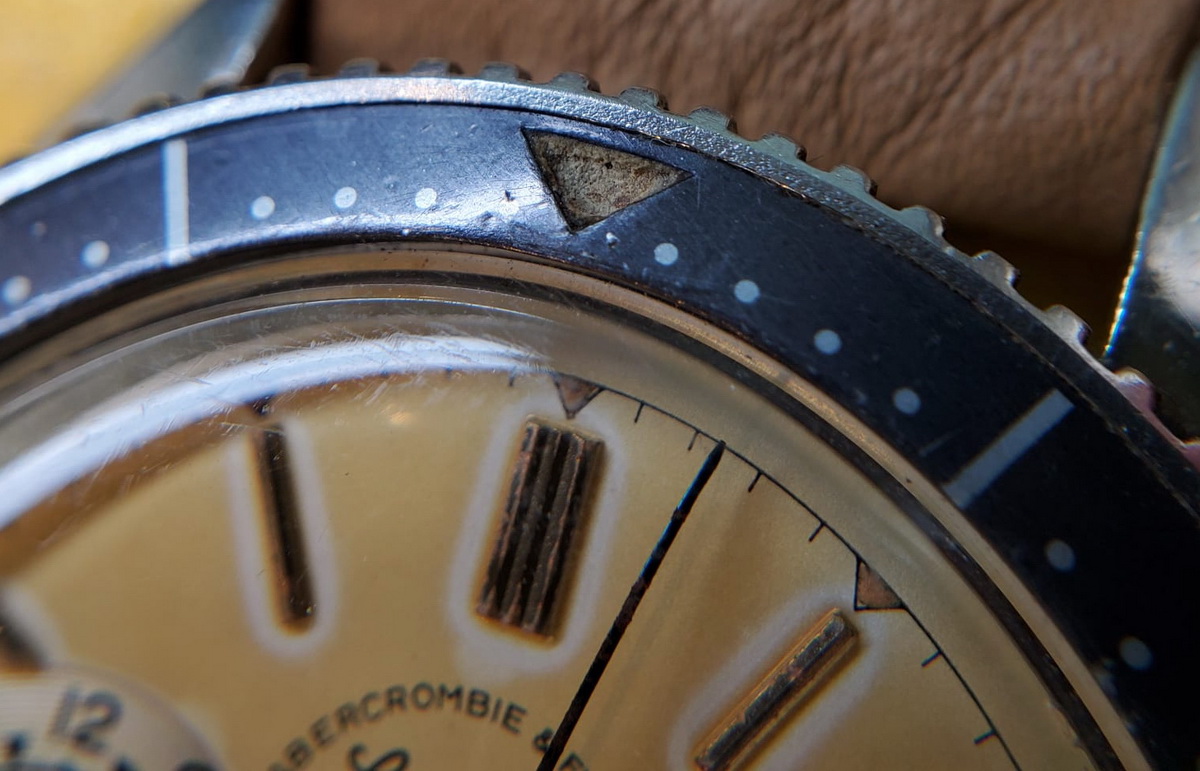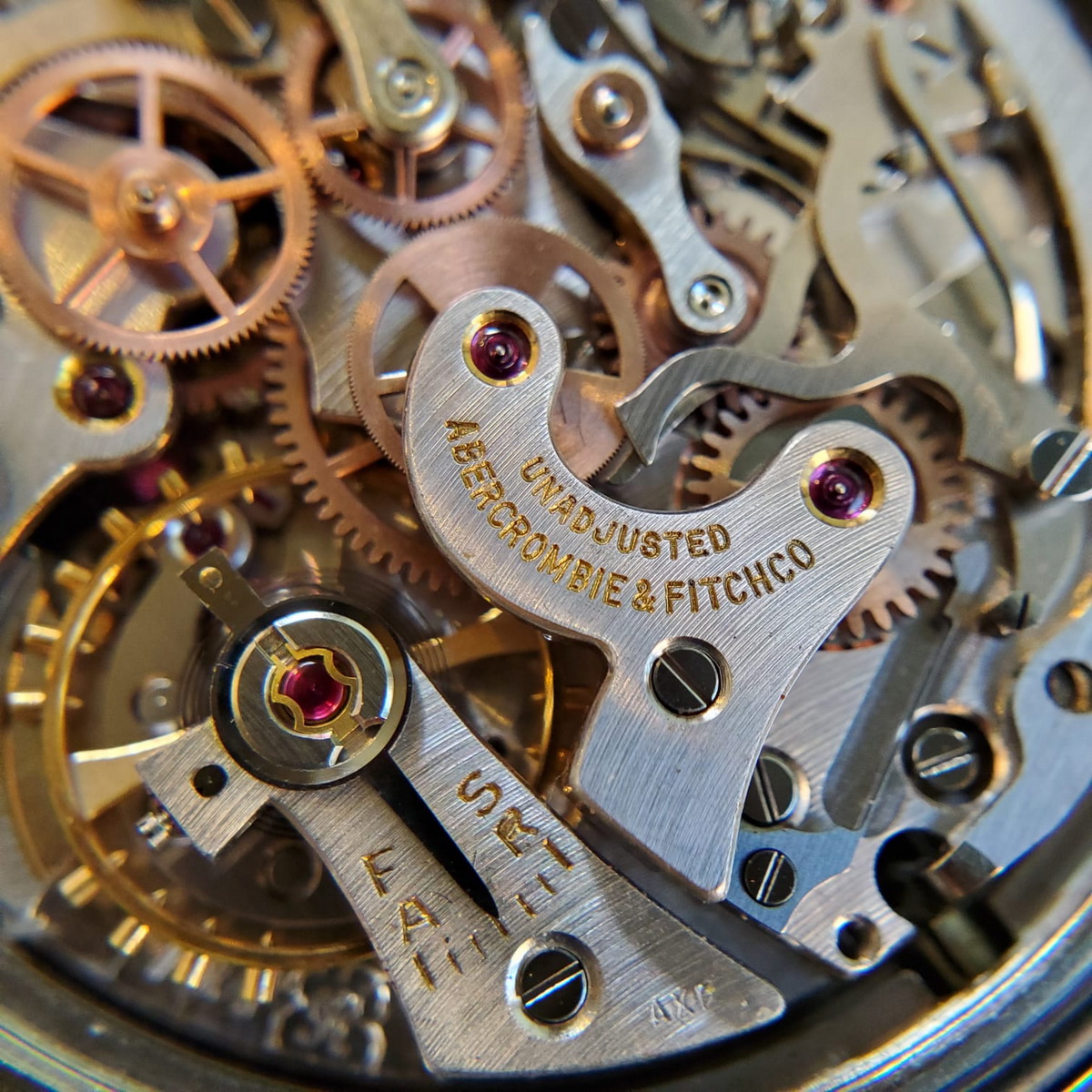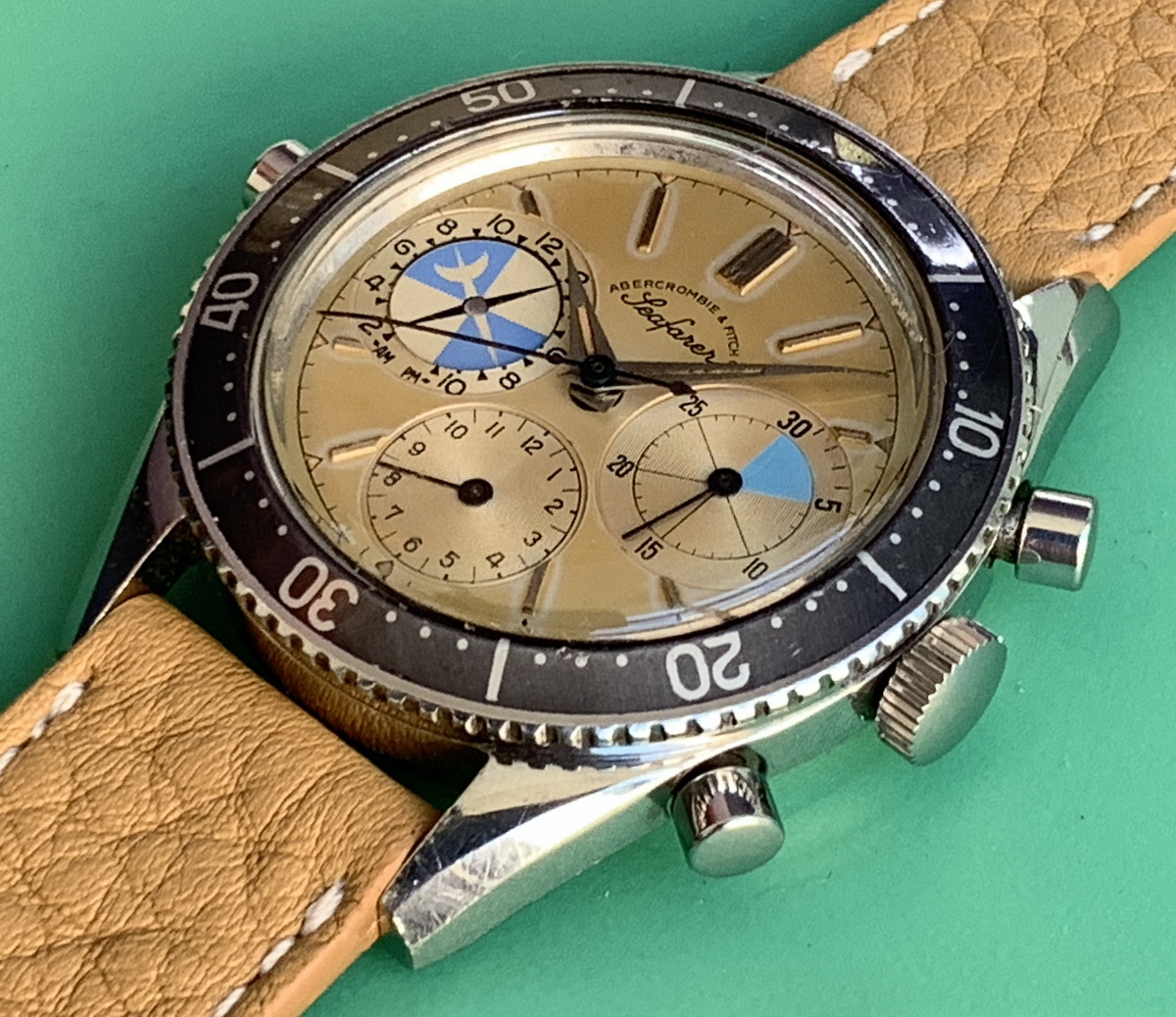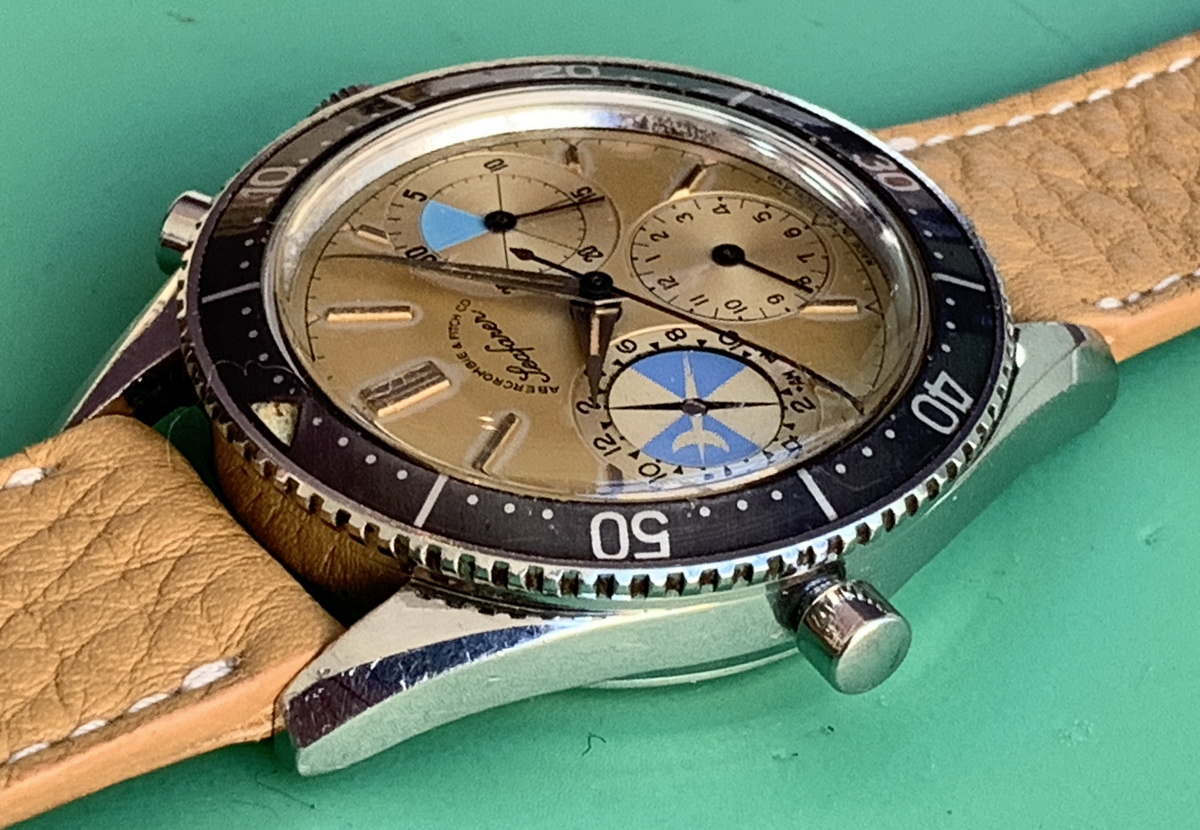In our May 2020 posting, Vintage Heuer – Chasing the Grails, we covered 16 watches that would be considered grails among vintage Heuer collectors. Our working definition of a “grail” watch had three parts. First, the model must be extremely rare. For most of the 16 watches that we included, the diligent collector would do well to see one or two watches offered per year. Second, the watch had to have a broad following in the community, so that if a watch was offered for sale, we could expect a large number of collectors to pursue the watch. Rare but unpopular will not make it a grail watch. Finally, a watch would be included in our list of grails only if is “attainable” by the enthusiastic collector, meaning that they could expect to find the watch offered for sale, during a year or two of searching. The “unobtainable” watches were not included.
In today’s “Noteworthy Watch” posting we cover the Abercrombie & Fitch Seafarer chronograph, in the Reference 2446 screw-back case (circa 1963). This model was not included in our list of grail watches as it would be considered “unattainable”, with the community having seen fewer than six of these watches over the past 20 years. But the good news is that a beautiful, one-owner sample of this chronograph will be offered for sale by Sotheby’s in its online sale “Fine Watches”, being held March 4 through March 19, 2021. Here is the catalog listing for this Seafarer.
UPDATE — On March 19, 2021, this Abercrombie & Fitch Seafarer, Reference 2446 (screw-back case) sold in the Sotheby’s “Fine Watches” auction for a final price of $94,500 (with a hammer pirce of $75,000 plus buyer’s commission).
To mark the occasion, we’ll provide an overview of the Abercrombie & Fitch Seafarers, then turn to the Seafarer Reference 2446 (screw-back model), and finally focus on the sample being offered for sale by Sotheby’s.
The Heuer / Abercrombie & Fitch Relationship
Calling itself the “Greatest Sporting Goods Store in the World”, in the first half of the twentieth century Abercrombie & Fitch offered top-quality gear for hunting, fishing, camping, safaris, climbing, driving, flying and other adventures. By 1960, Abercrombie & Fitch had three stores, located in New York, Chicago and San Francisco, with “seasonal” stores in Palm Beach and Sarasota, Florida (for the winter) and Hyannis, Massachusetts and Bay Head, New Jersey (for the summer).
Abercrombie & Fitch stores were destinations for ladies and gentlemen who wanted to be outfitted in the very best style. The 12-floor store on Madison Avenue in New York had its own shooting range, a pool for fly fishing lessons, and other attractions, as well as full-time watchmakers and gunsmiths. Abercrombie & Fitch published comprehensive catalogs, some showing the entire selection of merchandise and some focusing on specific seasons or lifestyles (hunting, fishing and travelling, for example).
As early as the mid-1930s, Heuer produced chronographs and watches for Abercrombie & Fitch on a private label basis. Walter Haynes, President of Abercrombie & Fitch, would visit Ed. Heuer & Co. in Switzerland twice each year, to consider new types of watches that might be of interest to sportsmen. The watches that Heuer produced for Abercrombie & Fitch were often innovative and were always Heuer’s highest-quality models. For example, the Abercrombie & Fitch chronographs always used stainless steel cases, even when some of the comparable Heuer models used chromium-plated cases.
In 1949, Heuer developed the “Solunar” watch for Abercrombie & Fitch, incorporating a “lunar” dial that would allow sportsmen to determine the best times of the month and the best times of day to hunt and fish, based on the positions of the moon, and, in the case of fishing, the tides. A 1949 brochure for the Solunar suggested that farmers could also use the lunar dial, to determine the best time for planting trees, picking fruit and many other activities.
In 1950, Heuer added the “lunar” dial to one of its most rugged three-register chronographs to create the Abercrombie & Fitch “Seafarer”.
Overview of the Abercrombie & Fitch Seafarer Chronographs
The Seafarer chronographs were produced from 1950 into the mid-1970s. Features shared by all models and executions include – three-register chronographs with a tide dial on the left of the dial (at 9 o’clock), minute recorder at 3 o’clock and hour recorder at 6 o’clock) and a stainless steel case designed to be waterproof (round pushers and screw-back or compressor snap-back). Beyond this short list of shared features, the Seafarers showed considerable variety in the use of different cases, dial colors, styles of hands and even movements. For detailed information about the origins and development of the Abercrombie & Fitch Seafarer chronographs, from one model to the next, see our posting The Definitive History of the Abercrombie & Fitch Seafarer Chronograph.
The essence of the Seafarer chronograph was a tide dial, located at nine o’clock, that rotated once each day to indicate the times for the high and low tides at a specific location. The following images show how a Seafarer chronograph would indicate the times of the times at a specific location for three days.
Heuer never produced a case specifically for the Seafarer; instead, all versions of the Seafarer chronograph resided in cases that were used for other Heuer chronographs. The Skipper line of chronographs shares this same distinction, residing in six different cases from 1968 into the mid-1980s, but never having a dedicated case of its own.
A quick summary of the development of the Seafarer models is as follows:
Reference 346. The first model of the Seafarer used the Heuer Reference 346 case and was powered by a modified version of the Valjoux 71 movement, a 14 ligne movement. The first execution of the Reference 346 Seafarer had a 180 degree cut-out for the tide dial; the second execution (as shown below) had a full 360 degree cut-out.
Reference 2443. Next, the Seafarer moved to the Reference 2443 case, with power coming from a modified version of the Valjoux 72 movement, a 13 ligne movement. The first execution of this model had luminous (radium) Arabic numerals and dots for the hours; the second execution used gold for the numerals and other hour markers.
Reference 2444. The third case to house the Seafarer was the Reference 2444 case, and again we see two executions. The first version had green and yellow tones for tide dial, with green and white for minute recorder. The second execution used a silver/white dial with light blue accents on the recorders, with applied markers taking the place of numerals to mark the hours. The second execution of the Reference 2444 Seafarer also saw Heuer’s first use of dauphine hands with thin luminous inserts for the Seafarer.
Reference 2446 (Screw-Back). The Reference 2446 screw-back case, as introduced for the Autavia in 1962, was the fourth case to house the Seafarer chronograph. The style of the dial and hands was carried forward from the previous Reference 2444 model, however, the rotating bezel on the larger (39 millimeter) case gave this model an entirely different look from any of the previous models.
Reference 2447. Case number five for the Seafarer was the Reference 2447, as used for the three-register Carrera chronograph. Once again the style of the dial and hands remained similar to the previous 2446 and 2444 models.
Reference 2446C (Compressor). The sixth and final case for the Seafarer was the Reference 2446C, the snap-back “compressor” case used for the Autavia. Compared with the Carrera Reference 2447 case, the new compressor case offered significantly improved waterproofing. The dial was restyled in a charcoal / black, with the first execution using polished steel hands and the second execution using bright white, aviator style hands.
Heuer Mareographe and Orvis Solunagraph
In addition to producing the Abercrombie & Fitch Seafarers, Heuer made most of the models and executions for sale under the Heuer brand, under the “Mareographe” name. The Mareographes are more rare than their Seafarer counterparts.
Heuer produced the Reference 2446C models for Orvis under the “Solunagraph” name.
The Abercrombie & Fitch Seafarer Reference 2446 (Screw-Back Case)
In our posting about on Hodinkee, The Rise of the Skipperrera, we described the factors that have combined to make the Skipperrera the most valuable of the vintage Heuer chronographs – strong back-story, capturing the style of the 1960s, very limited number produced, etc. Looking at the Abercrombie & Fitch Seafarer Reference 2446 being sold by Sotheby’s, we can make the case that this Seafarer should take its place alongside the Skipperrera at the very top of the vintage Heuer food chain.
The Reference 2446 screw-back version of the Seafarer will check many important boxes for the vintage Heuer collector. Through the collaboration with Abercrombie & Fitch, Heuer became the supplier of choice for the wealthy adventurer who wanted the very best gear. We can imagine the well-heeled fisherman or traveler making their way to the Abercrombie & Fitch store on Madison Avenue in New York City, to select the ideal watch for a beach vacation or fishing trip.
In 1962 the Autavia was an innovative new model for Heuer and we can imagine that it would have been an excellent choice, with the rotating bezel providing an extra tool that was not offered on Heuer’s previous chronographs. The superior waterproofing of the Autavia case, marked on the back as Guaranteed Waterproof to 300 Feet, would have also been attractive for the gentleman heading for the beach. The Autavia would continue in production for 25 years, but for the adventurer seeking the very best chronograph in 1962, this new model would have definitely been attractive as the “latest thing”.
There is no more scarce watch in the Heuer heritage catalog than the Seafarer in the Reference 2446 screw-back case. In addition to the watch being sold by Sotheby’s, I am aware of four samples of this watch that have been shown on the internet over the past 20 years, with only one previous public sale of this model (by Boule auction house, in July 2016). Compared with this model, we can say that vintage Heuer grails such as the Skipperrera, the first execution Autavia (with all-lume hands) and the “Yachting” Carrera are plentiful.
The Sample Being Sold by Sotheby’s
Looking at this specific watch, we have a new-to-market watch being sold by the family of the original owner, with an unpolished case and a dial that has aged to a unique color and finish. Fittingly for a Seafarer, the dial evokes the sand and the sea, the setting in which the chronograph was designed to be used.
Collectors dream of the “barn car”, found deep in the woods, covered by a ratty looking tarp, often with boxes of spare parts or other junk piled on top. In the watch world, the “sock drawer” is the equivalent of the country barn, with the sturdy drawer and soft socks providing the perfect environment for a watch to remain in perfect condition, or even improve, from one generation to the next. The Seafarer being auctioned by Sotheby’s is being sold by the family of the original owner, who wore the watch for a short while and then put it away in a drawer, where it spent the intervening decades.
The look of this Seafarer is unlike that of any other Seafarer that I have seen. When this watch left the Heuer factory, the dial of this chronograph would have been a silver / white or a cream / white, similar to the two models shown above (Reference 2444 and 2447). Over the years, however, the dial has aged to a creamy sand color, often called “tropical”, except that the area around each of the markets maintains the original lighter color. While we often see dials that have aged with some spots, streaks, blotches or other types of distress, the tone of this dial is perfectly even, across the entire dial, with no suggestion that the paint has been damaged by the elements – sunlight, humidity, temperature changes, etc. Perhaps a chemist can explain how this happened; I am happy living with the mystery of what caused the beautiful transformation of this dial.
Looking beyond the dial, this Seafarer appears to be in “original” condition. The case does not appear to have been polished, and the bezel appears to be original to the watch.
The Valjoux 721 movement looks pristine and operates properly, and all markings on the case and movement are as they should be.
So What’s It Worth?
Predicting the price that will be achieved for a rare watch in an auction is a difficult task. It is impossible to suggest a “fair market value” for this watch, as we have no comparable watches [in the plural] that have been sold publicly in recent years. If we put the vintage Heuer chronographs into tiers, I believe that this Seafarer belongs in the top tier, along with the Skipperreras, Chronomatic models, early Autavias and a handful of others.
Recently, we have seen vintage Heuer chronographs in the top tier change hands in the range between $60,000 and $100,000, when they are in excellent condition. Consider the “plusses” for the interesting one-owner provenance (“Barn Car” status), extreme scarcity (five known samples) and beautiful, tropical condition (the sea and the sand), and this watch should move to the top of that top tier. And if two bidders decide to do battle for this chronograph, we could see the highest price achieved for a Heuer since 2017, when we saw five Heuer chronographs sell in the $100,000 to $200,000 range.
And to think, none of those other five chronographs even had a tide dial.
Specifications – Abercrombie & Fitch Seafarer, Reference 2446 (Screw-Back Case)
Case – First execution Reference 2446 screw-back case; stainless steel; 38.7 millimeters across the dial, 48 millimeters lug-to-lug; 19 millimeters between the lugs (strap size), 13.5 millimeters thick; bi-directional rotating minutes bezel, with luminous triangle
Case serial number – 52898 (circa 1963)
Dial — marked “Abercrombie & Fitch Co. Seafarer”; white / tropical, with applied metal markers; chronograph minute recorder at three o’clock, chronograph hours recorder at six o’clock; tide dial at nine o’clock
Hands – dauphine with thin luminous inserts
Movement – Valjoux 721 (modified version of the Valjoux 72); 17 jewels; unadjusted; signed “Abercrombie & Fitch Co”
References
To see additional photos of the Seafarer being sold by Sotheby’s, see the Gallery below.
To see additional samples of the Seafarer Reference 2446 (screw-back case), see the OnTheDash Gallery of these watches.
To see any execution or model of the Abercrombie & Fitch Seafarer, see the OnTheDash index page for the Seafarers.
Thanks
Special thanks to Jonathan Burford, Richard Lopez and Christina Bohn, of Sotheby’s (New York City), for bringing this watch to market; thanks also for the wonderful hospitality when I visited Sotheby’s to meet you guys and to see this wonderful watch.
Thanks also to Shaun, @Neutrino14, for the photo in this posting, showing the group of six Seafarers and Mareographes.
Jeff Stein
March 3, 2021
